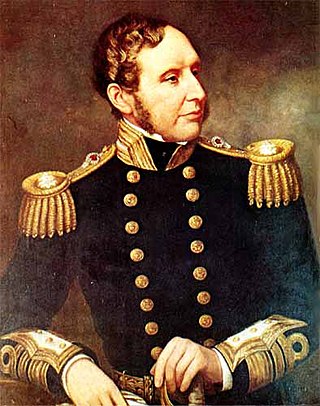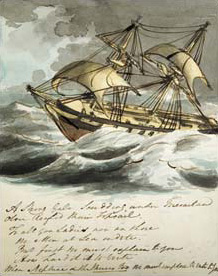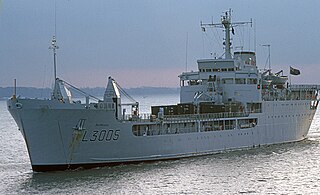
The history of the Falkland Islands goes back at least five hundred years, with active exploration and colonisation only taking place in the 18th century. Nonetheless, the Falkland Islands have been a matter of controversy, as they have been claimed by the French, British, Spaniards and Argentines at various points.

The Falklands War was a ten-week undeclared war between Argentina and the United Kingdom in 1982 over two British dependent territories in the South Atlantic: the Falkland Islands and its territorial dependency, South Georgia and the South Sandwich Islands. The conflict began on 2 April, when Argentina invaded and occupied the Falkland Islands, followed by the invasion of South Georgia the next day. On 5 April, the British government dispatched a naval task force to engage the Argentine Navy and Air Force before making an amphibious assault on the islands. The conflict lasted 74 days and ended with an Argentine surrender on 14 June, returning the islands to British control. In total, 649 Argentine military personnel, 255 British military personnel, and three Falkland Islanders were killed during the hostilities.

HMS Beagle was a Cherokee-class 10-gun brig-sloop of the Royal Navy, one of more than 100 ships of this class. The vessel, constructed at a cost of £7,803, was launched on 11 May 1820 from the Woolwich Dockyard on the River Thames. Later reports say the ship took part in celebrations of the coronation of King George IV of the United Kingdom, passing through the old London Bridge, and was the first rigged man-of-war afloat upriver of the bridge. There was no immediate need for Beagle, so she "lay in ordinary", moored afloat but without masts or rigging. She was then adapted as a survey barque and took part in three survey expeditions.

Simon Weston is a Welsh veteran of the British Army who is known for his charity work and recovery from severe burn injuries suffered during the Falklands War.

Vice-Admiral Robert FitzRoy was an English officer of the Royal Navy and a scientist. He achieved lasting fame as the captain of HMS Beagle during Charles Darwin's famous voyage, FitzRoy's second expedition to Tierra del Fuego and the Southern Cone.

TV Sir Tristram (L3505) formerly RFA Sir Tristram, is a Round Table-class landing ship logistics that was converted to a Special Forces Training Vessel in 2008. She was launched in 1966, and accepted into British Army service in 1967. As with others of her class, she was transferred to the Royal Fleet Auxiliary in 1970, and was crewed by British officers and Hong Kong Chinese sailors. The ship saw service in the Falklands War of 1982, and was badly damaged at Fitzroy on 8 June.

HMS Cardiff was a British Type 42 destroyer and the third ship of the Royal Navy to be named in honour of the Welsh capital city of Cardiff.

East Falkland is the largest island of the Falklands in the South Atlantic, having an area of 6,605 km2 or 54% of the total area of the Falklands. The island consists of two main land masses, of which the more southerly is known as Lafonia; it is joined by a narrow isthmus where the settlement of Goose Green is located, and it was the scene of the Battle of Goose Green during the Falklands War.

Weddell Island is one of the Falkland Islands in the South Atlantic, lying off the southwest extremity of West Falkland. It is situated 1,545 km (960 mi) west-northwest of South Georgia Island, 1,165 km (724 mi) north of Livingston Island, 606 km (377 mi) northeast of Cape Horn, 358 km (222 mi) northeast of Isla de los Estados, and 510 km (320 mi) east of the Atlantic entrance to Magellan Strait.

In December 1832, two naval vessels were sent by the United Kingdom to re-assert British sovereignty over the Falkland Islands, after the United Provinces of the Rio de la Plata ignored British diplomatic protests over the appointment of Luis Vernet as governor of the Falkland Islands and a dispute over fishing rights.
The British Antarctic Survey (BAS) is the United Kingdom's national polar research institute. It has a dual purpose, to conduct polar science, enabling better understanding of global issues, and to provide an active presence in the Antarctic on behalf of the UK. It is part of the Natural Environment Research Council (NERC). With over 400 staff, BAS takes an active role in Antarctic affairs, operating five research stations, one ship and five aircraft in both polar regions, as well as addressing key global and regional issues. This involves joint research projects with over 40 UK universities and more than 120 national and international collaborations.

Mare Harbour, known colloquially as East Cove Port, is a small settlement on East Falkland, on Choiseul Sound. It is mostly used as a port facility and depot for RAF Mount Pleasant, as well as a deepwater port used by the Royal Navy ships patrolling the South Atlantic and Antarctica, which means that the main harbour of the islands, Stanley Harbour tends to deal with commercial transport.

The Falkland Islands have a complex history stretching over five hundred years. Active exploration and colonisation began in the 18th century but a self-supporting colony was not established till the latter part of the 19th century. Nonetheless, the islands have been a matter of controversy, as due to their strategic position in the 18th century their sovereignty was claimed by the French, Spaniards, British and Argentines at various points.

RRS Shackleton was a Royal Research Ship operated by the British scientific research organisations the Falkland Islands Dependencies Survey (FIDS), British Antarctic Survey (BAS) and Natural Environment Research Council (NERC) in the Antarctic from 1955 to 1983. She was subsequently operated as a seismic survey vessel under the names Geotek Beta, Profiler and finally Sea Profiler before being scrapped in 2011.

The Argentine Military Cemetery, Spanish: Cementerio de Darwin, is a military cemetery on East Falkland that holds the remains of 236 Argentine combatants killed during the 1982 Falklands War. It is located at Fish Creek to the east of the Darwin Settlement the location of the Battle of Goose Green. There is a replica of the cemetery at Berazategui in Buenos Aires Province, Argentina.

The Bluff Cove air attacks occurred 8 June 1982, during the Falklands War. British troop transport ships were bombed by the Argentine Air Force (FAA) while unloading at Bluff Cove, with significant damage and casualties.

This Thing of Darkness was the debut novel of Harry Thompson, published in 2005 only months before his death in November of that year at the age of 45. Set in the period from 1828 to 1865, it is a historical novel telling the fictionalised biography of Robert FitzRoy, who was given command of HMS Beagle halfway through her first voyage. He subsequently captained her during the vessel’s famous second voyage, on which Charles Darwin travelled as his companion.

Gull Harbour is the 1.3 km wide bay indenting for 2.8 km the east coast of Weddell Island in the Falkland Islands. It is entered north of Gull Point and south of Mark Point, and is centred at 51°53′56″S60°53′20″W. The principal settlement of the island, Weddell Settlement, is situated at the head of the bay. Until the mid-nineteenth century Gull Harbour was known as Great Harbour.




















